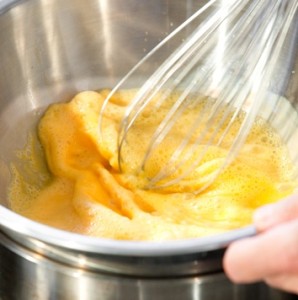Stocks And Mother Sauces: Emulsion Sauces
 Emulsion sauces are made from two liquids that do not naturally combine, like oil and vinegar. When an emulsion is created, the two ingredients are blended together to create a unique and luscious final product. Popular dressings like mayonnaise, hollandaise sauce and vinaigrettes are all popular emulsions. When the two are vigorously mixed, one substance is broken down into countless droplets that are suspended in the other substance. Emulsions are a great example of how science shows itself in the kitchen every day.
Emulsion sauces are made from two liquids that do not naturally combine, like oil and vinegar. When an emulsion is created, the two ingredients are blended together to create a unique and luscious final product. Popular dressings like mayonnaise, hollandaise sauce and vinaigrettes are all popular emulsions. When the two are vigorously mixed, one substance is broken down into countless droplets that are suspended in the other substance. Emulsions are a great example of how science shows itself in the kitchen every day.
When creating an emulsion in your online short course you will either need a strong arm to whisk the ingredients together or a blender or food processor. Because the ingredients of an emulsion are naturally prone to repel each other, separation is possible, but can be avoided with most emulsified sauces or dressings. To create a strong emulsion, start adding the fat – either butter or oil – very slowly as you vigorously whisk. Be sure that each addition is fully combined before adding more to the mixture. This will allow the droplets to fully combine, creating an even sauce. Some emulsions, like hollandaise, contain eggs which need to remain at a controlled temperature. If the mixture is heated the egg will cook, creating a lumpy and thin sauce – far from the luscious, creamy texture of a well made mayonnaise.
Due to the nature of the sauces, emulsions will sometimes break or separate. If an egg-based sauce fails to thicken properly, the oil may have been added too quickly and can be fixed by slowly whisking in an egg yolk beaten with a tablespoon of water or lemon juice. If oil and vinegar have separated in vinaigrette, simply whisk or shake the mixture back together. If a beurre blanc becomes thin, the sauce may be too hot and should be removed from heat and have ice chips whisked in. There are many ways to save an emulsion, and although common sense may say two ingredients do not work well together, your taste buds will say otherwise after tasting a successful emulsion.
Online Culinary School Planner & Checklist
Online Culinary School Planner & Checklist
Find out what a culinary education can do for you.

What might a career in the culinary or pastry arts look like for you? Online culinary school is a fast, affordable way to launch a career in the culinary or pastry arts. Get the workbook to see how it could help you.


If you like this post, please be sure to check out the following!
Stocks And Mother Sauces: The Five Building Blocks
Stocks And Mother Sauces: Make Your Own Stocks
Free Cooking Course – World Flavors: Salt, Spices, & Herbs





Recent Comments